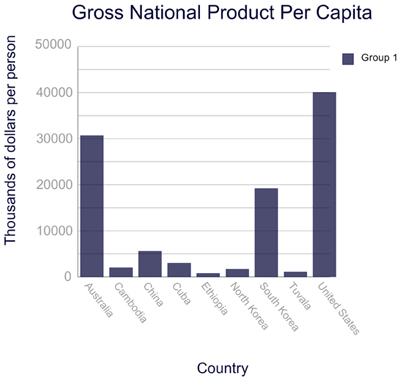|
Gross National Product per CapitaBoth command and market economies are characterized by specialization. An example of regional specialization in a market economy is the production of citrus fruit. The weather conditions in Florida and California are good for growing citrus fruits. Since citrus fruits cannot be grown in most other states, some California and Florida farmers have specialized in producing oranges and other citrus fruits. They ship their produce to areas where citrus fruits cannot be grown, such as Idaho. Farmers in Idaho cannot grow citrus fruits because the weather in Idaho is too cold in the winter; instead, many farmers in Idaho specialize in growing potatoes, which happen to flourish in Idaho's climate. Specialization is not limited to farming. Some areas, such as Detroit, Michigan, and Chicago, Illinois, produce cars and other automobiles. Alaska and Maine both specialize in fishing and marketing seafood. New York City is the banking center of the US. As you can see, specialization is diverse and can fill many needs.
Figure 8.3.1 shows the Gross Domestic Product (GDP) produced per person in 2004 for nine different countries. The GDP is the total value of all goods and services produced by a nation. The economies of Cambodia, Ethiopia, and Tuvalu are largely subsistence economies. The economies of China, Cuba, and North Korea are mostly command economies. The economies of the last three, Australia, South Korea, and the United States, are primarily market economies. There are many countries, besides those included in the graph, in which the economies are largely subsistence economies. At one time, many of the world's economies were strictly command economies; however, since the 1970s many of those countries have been adding elements of market economies to their command economies. After the breakup of the Soviet Union in the 1990s, many countries shifted their economies to market economies. The shift has not been easy, and in some cases has resulted in economic turmoil. As of 2006, China, Cuba, North Korea, and Vietnam are the main command economies remaining, although China (and each of the others to a lesser extent) has adopted many market economy practices. The other areas of the world rely primarily on market economies. As you can see when looking at Figure 8.3.1, market economies generally have the highest GDP, which means they produce the largest amounts of goods and services per person. Although economies tend to be based primarily on one of the three types mentioned above, almost all economies also include some aspects of the other types of economies. For instance, in both command and market economies, it is possible to find families who live a subsistence lifestyle. These people are found mainly in isolated rural areas. People that live subsistence lifestyles usually live in small, simple homes which they heat with wood or other fuel that they have gathered themselves. They also grow all of their food on small plots of land. Their work is not specialized, but instead is directed towards producing the products necessary to fulfill basic needs for themselves and their families. There are some areas within the former Soviet Union in which people must grow much of their own food in order to supplement that which is available to purchase. For instance, in many areas of Ukraine, people who work and live in the city also have small plots of land in rural areas. These people travel by train to their small gardens each weekend to tend and cultivate the produce. Much of the food that they eat comes directly from their own garden. Most market economies also include some aspects of command economies. For example, Canada has a market economy; however, the government controls the healthcare system, determining where and what services are offered and ensuring equal access to all citizens. The US government also has several programs where sources are controlled and allocated by the government. Programs such as welfare, low income housing programs, farm subsidies, and Social Security are controlled by the government rather than being controlled by market forces. As mentioned earlier, the remaining command economies also include some aspects of market economies. Since 1978, the Chinese government has incorporated some aspects of a market economy into their economy. Rather than the central government controlling every aspect of the economy, villages and households have been given the opportunity to make some economic decisions regarding farming and small-scale production of goods. Within a limited scope, the local government is allowed to determine which crops the area can most efficiently grow and which products they can best produce. Consequently, China's GDP has experienced remarkable growth since the 1970s.  
|
About Us | Terms of Use | Contact Us | Partner with Us | Press Release | Sitemap | Disclaimer | Privacy Policy
©1999-2011 OpenLearningWorld . com - All Rights Reserved


